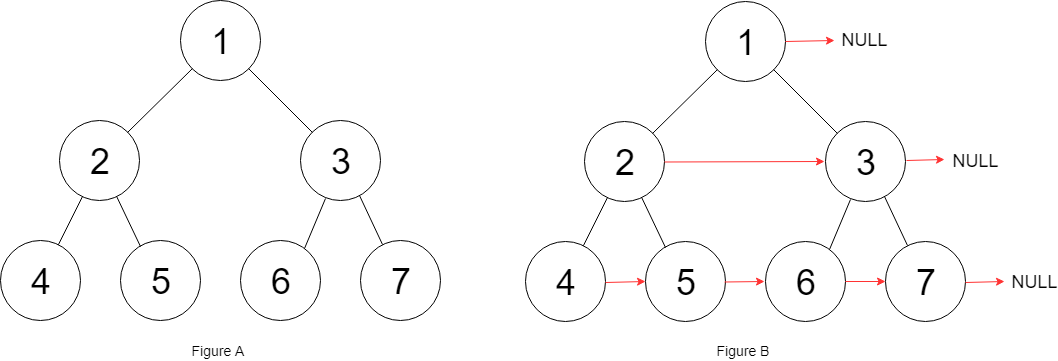您好,登錄后才能下訂單哦!
您好,登錄后才能下訂單哦!
這篇文章主要介紹“C++如何實現每個節點的右向指針”,在日常操作中,相信很多人在C++如何實現每個節點的右向指針問題上存在疑惑,小編查閱了各式資料,整理出簡單好用的操作方法,希望對大家解答”C++如何實現每個節點的右向指針”的疑惑有所幫助!接下來,請跟著小編一起來學習吧!
Given a binary tree
struct Node {
int val;
Node *left;
Node *right;
Node *next;
}
Populate each next pointer to point to its next right node. If there is no next right node, the next pointer should be set to NULL.
Initially, all next pointers are set to NULL.
Follow up:
You may only use constant extra space.
Recursive approach is fine, you may assume implicit stack space does not count as extra space for this problem.
Example 1:

Input: root = [1,2,3,4,5,null,7]
Output: [1,#,2,3,#,4,5,7,#]
Explanation: Given the above binary tree (Figure A), your function should populate each next pointer to point to its next right node, just like in Figure B. The serialized output is in level order as connected by the next pointers, with "#" signifying the end of each level.
Constraints:
The number of nodes in the given tree is less than 6000.
-100 <= node.val <= 100
這道是之前那道 Populating Next Right Pointers in Each Node 的延續,原本的完全二叉樹的條件不再滿足,但是整體的思路還是很相似,仍然有遞歸和非遞歸的解法。我們先來看遞歸的解法,這里由于子樹有可能殘缺,故需要平行掃描父節點同層的節點,找到他們的左右子節點。代碼如下:
解法一:
class Solution {
public:
Node* connect(Node* root) {
if (!root) return NULL;
Node *p = root->next;
while (p) {
if (p->left) {
p = p->left;
break;
}
if (p->right) {
p = p->right;
break;
}
p = p->next;
}
if (root->right) root->right->next = p;
if (root->left) root->left->next = root->right ? root->right : p;
connect(root->right);
connect(root->left);
return root;
}
};對于非遞歸的方法,我驚喜的發現之前的方法直接就能用,完全不需要做任何修改,算法思路可參見之前的博客 Populating Next Right Pointers in Each Node,代碼如下:
解法二:
class Solution {
public:
Node* connect(Node* root) {
if (!root) return NULL;
queue<Node*> q;
q.push(root);
while (!q.empty()) {
int len = q.size();
for (int i = 0; i < len; ++i) {
Node *t = q.front(); q.pop();
if (i < len - 1) t->next = q.front();
if (t->left) q.push(t->left);
if (t->right) q.push(t->right);
}
}
return root;
}
};雖然以上的兩種方法都能通過 OJ,但其實它們都不符合題目的要求,題目說只能使用 constant space,可是 OJ 卻沒有寫專門檢測 space 使用情況的 test,那么下面貼上 constant space 的解法,這個解法也是用的層序遍歷,只不過沒有使用 queue 了,我們建立一個 dummy 結點來指向每層的首結點的前一個結點,然后指針 cur 用來遍歷這一層,這里實際上是遍歷一層,然后連下一層的 next,首先從根結點開始,如果左子結點存在,那么 cur 的 next 連上左子結點,然后 cur 指向其 next 指針;如果 root 的右子結點存在,那么 cur 的 next 連上右子結點,然后 cur 指向其 next 指針。此時 root 的左右子結點都連上了,此時 root 向右平移一位,指向其 next 指針,如果此時 root 不存在了,說明當前層已經遍歷完了,重置 cur 為 dummy 結點,root 此時為 dummy->next,即下一層的首結點,然后 dummy 的 next 指針清空,或者也可以將 cur 的 next 指針清空,因為前面已經將 cur 賦值為 dummy 了。那么現在想一想,為什么要清空?因為用 dummy 的目的就是要指到下一行的首結點的位置即 dummy->next,而一旦將 root 賦值為 dummy->next 了之后,這個 dummy 的使命就已經完成了,必須要斷開,如果不斷開的話,那么假設現在 root 是葉結點了,那么 while 循環還會執行,不會進入前兩個 if,然后 root 右移賦空之后,會進入最后一個 if,之前沒有斷開 dummy->next 的話,那么 root 又指向之前的葉結點了,死循環誕生了,跪了。所以一定要記得清空哦。
這里再來說下 dummy 結點是怎樣指向每層的首結點的前一個結點的,過程是這樣的,dummy 是創建出來的一個新的結點,其目的是為了指向 root 結點的下一層的首結點的前一個,具體是這么做到的呢,主要是靠 cur 指針,首先 cur 指向 dummy,然后 cur 再連上 root 下一層的首結點,這樣 dummy 也就連上了。然后當 root 層遍歷完了之后,root 需要往下移動一層,這樣 dummy 結點之后連接的位置就正好賦值給 root,然后 cur 再指向 dummy,dummy 之后斷開,這樣又回到了初始狀態,以此往復就可以都連上了,代碼如下:
解法三:
class Solution {
public:
Node* connect(Node* root) {
Node *dummy = new Node(-1), *cur = dummy, *head = root;
while (root) {
if (root->left) {
cur->next = root->left;
cur = cur->next;
}
if (root->right) {
cur->next = root->right;
cur = cur->next;
}
root = root->next;
if (!root) {
cur = dummy;
root = dummy->next;
dummy->next = NULL;
}
}
return head;
}
};到此,關于“C++如何實現每個節點的右向指針”的學習就結束了,希望能夠解決大家的疑惑。理論與實踐的搭配能更好的幫助大家學習,快去試試吧!若想繼續學習更多相關知識,請繼續關注億速云網站,小編會繼續努力為大家帶來更多實用的文章!
免責聲明:本站發布的內容(圖片、視頻和文字)以原創、轉載和分享為主,文章觀點不代表本網站立場,如果涉及侵權請聯系站長郵箱:is@yisu.com進行舉報,并提供相關證據,一經查實,將立刻刪除涉嫌侵權內容。